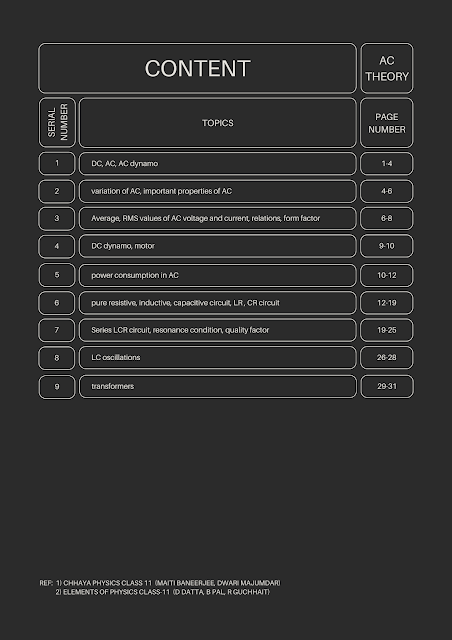Unit-4:Chp-2: Alternating Current
PHYSICXION: Alternating current (AC) is a type of electrical current where the direction of the flow of electrons reverses itself periodically.
A brief view of its history:
The concept of AC current has a rich history, with key contributions from various scientists and engineers over a span of centuries. Here's a glimpse into its development:
- ➤ Early Experiments (1820s-1850s):
1. French physicist Antoine Becquerel observed the first signs of AC in the 1820s while studying the effects of electrolytes.
2. In the 1830s, Michael Faraday, a prominent British scientist, discovered electromagnetic induction, the principle behind generating AC currents.
3. Hippolyte Pixii, another French scientist, built the first AC generator in 1832, laying the groundwork for future developments.
- ➤ War of the Currents (1880s):
1. The 1880s saw fierce competition between two prominent figures in electricity: Thomas Edison and George Westinghouse.
2. Edison championed direct current (DC) for powering homes and businesses, while Westinghouse advocated for AC.
3. AC offered advantages in transmission efficiency over long distances, thanks to the use of transformers. However, early AC technology wasn't well-suited for powering light bulbs, which was Edison's focus.
The "War of the Currents" ultimately favored AC, as advancements in AC motors and lighting systems solidified its benefits.
- ➤ Key Players and Developments (1880s-1900s):
- Several figures played crucial roles in advancing AC technology:
1. Hungarian Ganz Works developed early AC power transmission systems.
2. Nikola Tesla, a Serbian-American inventor, made significant contributions to AC motors and transformers.
3. William Stanley, an American engineer, is credited with creating the first practical transformer in the US.
4. German engineers like Sebastian Ziani de Ferranti and Werner von Siemens contributed to AC generator and transmission technology.
1. By the early 20th century, AC had become the dominant form of electrical current for power transmission and distribution.
2. Advancements in AC technology continued, with improvements in transmission lines, transformers, and control systems.
Interesting facts:
Here are a few interesting and lesser-known facts about AC current
- The "hum" from power lines: The constant hum you hear near power lines is actually the sound of the AC current vibrating the lines at the frequency of the current. In the US, this hum is at 60 Hz, which falls within the range of human hearing.
- The "skin effect": When AC current flows through a conductor, it tends to concentrate near the surface rather than flowing uniformly throughout. This is called the skin effect. It happens because the changing magnetic field generated by the current induces opposing currents within the conductor itself, pushing the main current toward the surface. This effect becomes more pronounced at higher frequencies.
- Tesla coil and wireless power transmission: Nikola Tesla, a pioneer of AC technology, envisioned a world where electricity could be transmitted wirelessly. He developed the Tesla coil, a high-voltage transformer that can produce electrical arcs at a distance. Although not used for large-scale power transmission, the principle of wireless power transfer is finding applications in modern devices like smartphones with wireless charging.
- AC and the Northern Lights: The colorful auroras, also known as the Northern Lights (Aurora Borealis) and Southern Lights (Aurora Australis), are caused by charged particles from the sun interacting with Earth's magnetosphere. These particles, primarily electrons, are funneled down towards the poles along magnetic field lines and collide with atoms and molecules in the upper atmosphere, causing them to emit light. This interaction creates spectacular auroral displays. Interestingly, the motion of these charged particles can be described as a flow of current, albeit on a much grander scale than the AC current in our power lines.
- AC and musical instruments: The sound produced by electric guitars is a result of interactions between the vibrating strings, magnetic pickups, and the AC current flowing through the instrument's circuitry. The pickups convert the vibrations of the strings into electrical signals, which are then shaped and amplified by the electronics before being delivered to the speakers. The unique tonal characteristics of electric guitars are heavily influenced by these interactions with AC currents.
DISCLAIMER: READ, DOWNLOAD, LEARN. SINCE THIS IS COPYRIGHTED CONTENT, DON'T UPLOAD IT ANYWHERE ON THE WEB OR SELL HARD COPY. IF ANY LINK ISSUE HAPPENS, PLEASE CONTACT US.
CLASS NOTES:
Here, full Class Notes PDFs are attached, which will help you score well in the exam.
NOTE-1: Theory of Alternating Current.
NOTE-2: Solved Numerical (Easy and moderate-level descriptive problems)
Look at the contents: PURCHASE OR VIEW THE FINAL MATERIAL FROM HERE:
 |
NOTE-1 |
 |
NOTE-2 |
 |
NOTE-2 |




Join the conversation